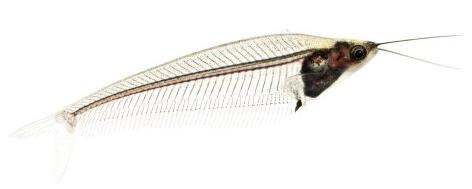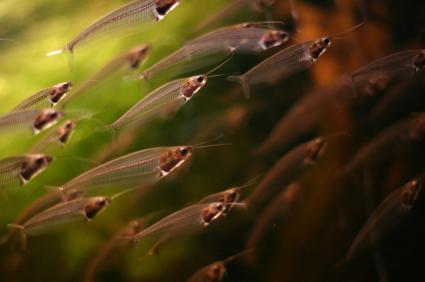Glass Catfish

Glass catfishes (Kryptopterus bicirrhis) are from Borneo, Sumatra, and Thailand. This fish is unusual because you can see through to its bones and internal organs.
Glass catfishes grow to about 4 inches or 10 cm in length. They have 2 barbels on the upper part of their mouth and have iridescent, scaleless bodies.
They are peaceful fish and can be kept in a community tank as long as their tankmates are peaceful. They usually swim along the middle layer of the tank. You must keep at least two glass catfish together in your aquarium and preferably a couple more. This is a shoaling fish and glass catfish do not survive in a tank without other members of their own species. This means if you only have 2 glass catfish and one of them dies you MUST go out and buy another one because the remaining one won't survive on its own. It is also best to keep glass catfish together that are of similar size if possible.

Not only is the name glass catfish appropriate because you can see right through them, but they are also fragile fish. Sometimes they don't even survive the trip home from the pet store.
You should provide plenty of plants in your aquarium for these fish so that they feel safe. They are somewhat shy fish and will fare much better if they have some hiding places.
They prefer soft, neutral to slightly acidic water, and the water temperature should be between 70-79 degrees Fahrenheit or 21-26 degrees Celsius.
They are egglaying fish, but so far breeding them in captivity has not been successful. This means that the glass catfish you see in pet stores have been recently taken from their natural environment. As a result, they may be stressed.
Glass catfish strongly prefer live foods. This is probably because this is what they were used to eating before they were taken into captivity. They will usually learn to eat freeze-dried, frozen food (thaw it first), and flakes. Even if they will eat the other types of foods you should try to supplement their diet with some live foods such as brine shrimp and small insects or insect larvae if possible.
